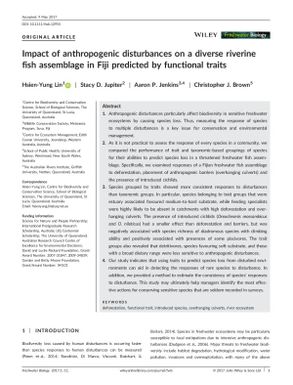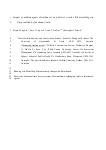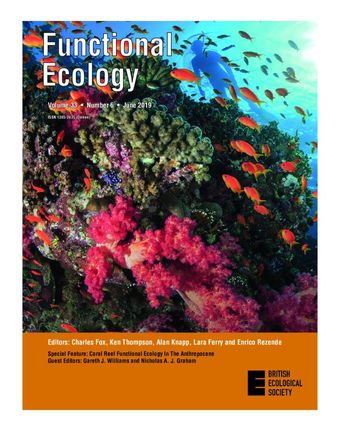Impact of anthropogenic disturbances on a diverse riverine fish assemblage in Fiji predicted by functional traits
- Description:
- 1. Anthropogenic disturbances particularly affect biodiversity in sensitive freshwater ecosystems by causing species loss. Thus, measuring the response of species to multiple disturbances is a key issue for conservation and environmental management. 2. As it is not practical to assess the response of every species in a community, we compared the performance of trait and taxonomic-based groupings of species for their abilities to predict species loss in a threatened freshwater fish assemblage. Specifically, we examined responses of a Fijian freshwater fish assemblage to deforestation, placement of anthropogenic barriers (overhanging culverts) and the presence of introduced cichlids. 3. Species grouped by traits showed more consistent responses to disturbances than taxonomic groups. In particular, species belonging to trait groups that were estuary associated favoured medium-to-hard substrate, while feeding specialists were highly likely to be absent in catchments with high deforestation and overhanging culverts. The presence of introduced cichlids (Oreochromis mossambicus and O. niloticus) had a smaller effect than deforestation and barriers, but was negatively associated with species richness of diadromous species with climbing ability and positively associated with presences of some piscivores. The trait groups also revealed that detritivores, species favouring soft substrate, and those with a broad dietary range were less sensitive to anthropogenic disturbances. 4. Our study indicates that using traits to predict species loss from disturbed environments can aid in detecting the responses of rare species to disturbance. In addition, we provided a method to estimate the consistency of species responses to disturbance. This study may ultimately help managers identify the most effective actions for conserving sensitive species that are seldom recorded in surveys.
- Display date:
- 2017
- Collections:
- Secretariat of the Pacific Regional Environment Programme (SPREP)
- Publisher:
- Wiley
- Content partner:
- Secretariat of the Pacific Regional Environment Programme (SPREP)
- Availability:
- Not specified
-
Copyright status: All rights reservedFind out more about what you are able to do with this itemThis item is all rights reserved, with means you'll have to get permission from Secretariat of the Pacific Regional Environment Programme (SPREP) before using it. For more information, please see our use and reuse page.What can I do with this item?Non-infringing useNZ copyright law does not prevent every use of a copyright work, and this item may be hosted by an international institute or organisation. You should consider what you can and cannot do with a copyright work.No sharingYou may not copy and/or share this item with others without further permission. This includes posting it on your blog, using it in a presentation, or any other public use.No modifyingYou are not allowed to adapt or remix this item into any other works.No commercial useYou may not use this item commercially.
Related items
Welcome and warm Pasifik greetings
The information on this site has been gathered from our content partners.
The names, terms, and labels that we present on the site may contain images or voices of deceased persons and may also reflect the bias, norms, and perspective of the period of time in which they were created. We accept that these may not be appropriate today.
If you have any concerns or questions about an item, please contact us.


